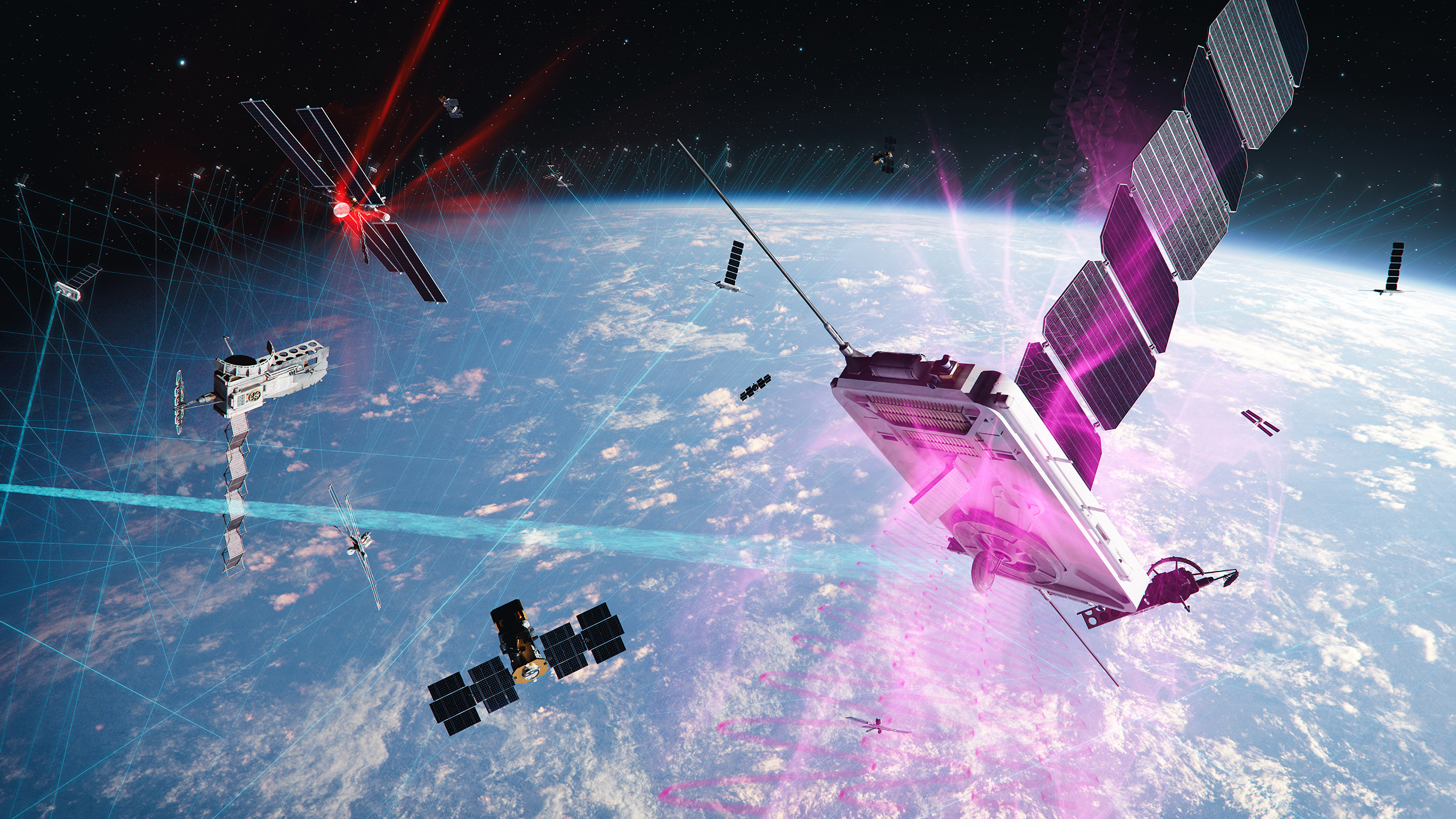Secretive SpaceX satellites operated by US government are shooting disruptive radio signals into space, astronomer accidentally discovers
An amateur astronomer has accidentally uncovered a series of puzzling radio signals coming from SpaceX's government-operated "Starshield" network. The signals overlap with protected frequencies and could disrupt other nearby spacecraft, experts warn.

SpaceX's secretive "Starshield" government-operated intelligence satellites are deliberately emitting radio signals the "wrong way around," and outside of the frequency ranges designated by international authorities, a new paper has revealed.
The signals, which were accidentally discovered by an amateur astronomer, may have the potential to negatively impact other spacecraft around them, NPR recently reported.
Starshield satellites are an offshoot of SpaceX's ever-expanding Starlink constellation that have been specially built for and operated by branches of the U.S. government. Very little is known about the Starshield program, which was first announced in 2023, including where the satellites are positioned around Earth, what their mission parameters are, or how they differ from standard Starlink satellites, according to Live Science's sister site Space.com.
SpaceX has launched dozens of Starshield batches into space so far. They likely total more than 200 individual satellites, although the exact number is unclear. The majority of the satellites are operated by the National Reconnaissance Office (NRO), while a small number are controlled by the U.S. Space Force. In total, the U.S. government has paid an estimated $1.8 billion for the Starshield network, according to The Wall Street Journal.
On Oct. 17, Scott Tilley, an amateur astronomer and citizen scientist who has previously tracked China's mysterious space plane and rediscovered a lost NASA satellite, released a new paper describing a series of anomalous satellite signals. Tilley initially came across these signals by mistake, after switching his equipment to a frequency range that is almost never used by satellites, and he was initially unsure what was causing them.

"It was just a clumsy move at the keyboard," Tilley told NPR. "I was resetting some stuff and then all of a sudden I'm looking at the wrong antenna, the wrong band." After comparing the signals to data collected from other amateur astronomers, he realized that they were likely coming from Starshield satellites, which he "wasn't expecting at all." (Tilley's findings have not yet been peer-reviewed.)
The new signals have frequencies between 2,025 and 2,110 megahertz, which are normally used for "uplink" signals, sent from Earth-based operators up into space. But in this case, these frequencies are being used to send "downlinks," or messages from satellites back to the planet's surface. As a result, the signals do not fall within the downlink frequencies approved by the International Telecommunication Union (ITU) — a United Nations agency that coordinates the use of the radio spectrum across the globe and in space.
Get the world’s most fascinating discoveries delivered straight to your inbox.
"These signals seem to be intentionally emitted by Starshield satellites, but outside of permitted frequency ranges," Benjamin Winkel, a radio astronomer at the Max Planck Institute of Radio Astronomy in Germany, told Live Science. But it is unclear why they are using uplink signals instead of standard downlink frequencies, he added.
In addition to potentially revealing the satellites' classified locations, Tilley warned that the Starshield signals could disrupt other spacecraft: "Nearby satellites could receive radio-frequency interference and could perhaps not respond properly to commands — or ignore commands — from Earth," he told NPR.
But not everyone is convinced. "I think it [the signals] is definitely happening," Kevin Gifford, a computer science professor at the University of Colorado, Boulder, who specializes in radio interference from spacecraft, told NPR. However, it is too soon to tell if these signals interfere with other spacecraft, and no such incidents have been reported so far, he added.

Tilley detected signals coming from 170 different Starshield satellites, hinting that the downlinks are probably being used by the entire constellation. This further suggests that the signals are being emitted on purpose, which some experts find unsurprising.
"SpaceX is smart and savvy," Gifford said. It's possible they decided to just "do it and ask forgiveness later," he added.
Neither SpaceX nor the NRO has commented on the newly discovered signals so far.
Disruptive SpaceX signals
This is not the first time SpaceX has run into issues regarding radio signals.
In 2023, a group of astronomers revealed that Generation 1 Starlink satellites are accidentally leaking a large amount of radio pollution, known as unintended electromagnetic radiation (UEMR), into space — and that the frequencies of these signals overlap with those used by radio astronomers. A follow-up study, in 2024, also revealed that Generation 2 Starlinks are leaking even more UEMR than their Generation 1 counterparts.

This problem is likely to get much worse as the number of private satellites increases. For example, SpaceX recently launched its 10,000th Starlink satellite into orbit. And while not all of those satellites remain operational, those that do represent around 60% of the roughly 12,000 active satellites currently orbiting our planet. Some experts also predict that we could end up with around 100,000 satellites by 2050.
Earlier this year, Live Science revealed that, if left unchecked, the UEMR from these future satellites could eventually disrupt all forms of ground-based radio astronomy, significantly handicapping our ability to study the cosmos.
Initial observations suggest that the new Starshield signals will not have a major impact on radio astronomy, Winkel said. However, like every other private satellite, they will likely be emitting some form of UEMR, he added.

Harry is a U.K.-based senior staff writer at Live Science. He studied marine biology at the University of Exeter before training to become a journalist. He covers a wide range of topics including space exploration, planetary science, space weather, climate change, animal behavior and paleontology. His recent work on the solar maximum won "best space submission" at the 2024 Aerospace Media Awards and was shortlisted in the "top scoop" category at the NCTJ Awards for Excellence in 2023. He also writes Live Science's weekly Earth from space series.
You must confirm your public display name before commenting
Please logout and then login again, you will then be prompted to enter your display name.
